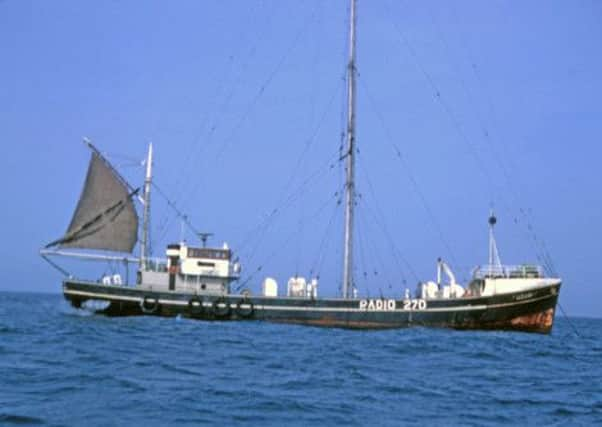A life on the ocean (medium) wave


The reception was often poor, the signal crackling and fluctuating, but it was the only way to hear the latest offerings from bands like the Beatles, Rolling Stones, Kinks, Hollies, the Who and many more fronting the decade’s music revolution.
Broadcasting from the east Yorkshire coast and attracting listeners over the North of England, and Midlands and even overseas, was Radio 270.
Advertisement
Hide AdAdvertisement
Hide AdWork had begun in November 1965 by a group of Northern businessmen to set up an off-shore commercial radio station. These men included Wilf Proudfoot, a former Member of Parliament for Cleveland who became the Managing Director of Radio 270. He was the owner of a chain of supermarkets and an adventurous man with a dynamic personality. The chairman of Radio 270 was Leonard Dale MD of a thriving electrical concern exporting British made goods to the world. Also involved were promoter Don Robinson, local fisherman Bill Pashby and farmer Roland Hill.
They all believed that folk in the North and Midlands were entitled to competitive commercial radio. During 1966, a Dutch lugger ‘Oceaan 7’ (first launched in 1939) was acquired and experienced tradesmen and commercial radio personnel set to work converting the ship from stem to stern into a pirate radio station at a cost of around £75,000.
Publicity announced the ship would house the North’s first commercial radio and shouted: ‘It’s not just a station, it’s a sensation.’
Originally to be called Radio Yorkshire, the station became Radio 270, named after its wavelength, and intended to play, between 6.30 am to 1 am, the top selling records of the day, as well as hourly news bulletins, sports flashes and weather and community announcements.
Advertisement
Hide AdAdvertisement
Hide AdThe ship emerged flying the Honduran flag after being registered in Puerto Cortes. Sailing into the North Sea, and anchoring four miles off the East Coast at Scarborough, Radio 270 began transmitting commercial radio during June 1966.
For those interested in technical details Oceaan 7 was 139ft long, 22ft wide, weighed 160 tons, and the mast was 154ft above sea level. There was a water distillery unit on board, the gallery had every modern appliance and the aerial was of the vertical birdcage construction. All modern navigational and life saving aids were on the ship. The transmitter was 10 kilowatts and manufactured by RCA.
In subsequent months Radio 270 floated around between Scarborough and Bridlington, depending on weather conditions and the Captain’s predilections for deep sea fishing! Oceaan 7 was commanded alternately by two captains, on a month on, month off basis. The highly skilled crew and technical staff worked on a fortnightly roster.
The DJ turn-over at Radio 270 was high and many have special memories of life on board the ship. Some are catalogued on www.offshoreradio.co.uk one of the many websites recalling the halcyon days of pirate radio stations.
Advertisement
Hide AdAdvertisement
Hide AdPaul Burnett recalled: ‘I was on the ship when the mast came down and it was seriously terrifying. There was a clear blue sky but the waves were just enormous. The mast snapped off about two-thirds of the way down. It was my first day at sea and I was extremely sea-sick. The top part of the mast was waving around and the crew had to try to cut it all free. We were very worried that it might tip the ship over.’
‘Neddy’ Noel Miller said: ‘We had fish feasts beyond belief when trawlers pulled alongside and gave us baskets of seafood in exchange for playing their requests. We went through a lot of cooks. Some couldn’t handle the weather and some just couldn’t cook!
David Sinclair added: ‘Life on the Oceaan 7 could easily drive one demented. Picture a large square dining table and benches in the middle, and then a series of bunk beds down the two sides, leaving the front and back ends of the room for people to manoeuvre in and out of the room. To put things in a nutshell, you could enjoy breakfast in bed simply by putting your hand through the drapes fronting your bunk and remove someone’s plate of food from the table. Yes, it was that close!’
But, perhaps the funniest moment happened when a DJ vomited on air whilst reading out an advert for Proudfoot’s bacon.
Advertisement
Hide AdAdvertisement
Hide AdA daily tender vessel from Scarborough kept the DJs in touch with the world outside, and brought out books, magazines, newspapers, personal mail and, of course, supplies and provisions for the ship.
At the Radio 270 offices in Scarborough thousands of letters were received by the station weekly. In charge of Press and PR was Margaret Lucas. With her was Carole Miller, responsible for liaison between ship and shore for DJs.
Radio 270 had a reach of 100 miles and approx. 15 million listeners. But, time was called on this and other pirate radio stations in August 1967 following the introduction of the Marine Offences Broadcasting Act. This made it illegal for all British citizens to supply or advertise with offshore radio stations.
DJ Vince ‘Rusty’ Allen closed Radio 270 at one minute to midnight on 14 August 1967. Many former Radio 270 went on to enjoy distinguished careers in mainstream broadcasting.